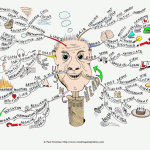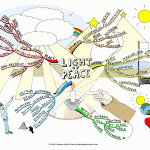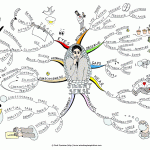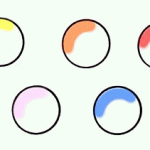The Yin and Yang symbol represents the balance of opposites in the universe or said another way balance and harmony.
When they are equally present, all is calm.
When one is outweighed by the other, there is confusion and disarray.
Since nothing in nature is purely black or purely white, the symbol includes a small black spot in the white swirl, and a corresponding white spot in the black swirl.
Yin, the darker element, is passive, dark, feminine, downward-seeking, and corresponds to the night; yang, the brighter element, is active, light, masculine, upward-seeking and corresponds to the day; yin is often symbolized by water, while yang is symbolized by fire.
Ultimately, the yin and yang can symbolize any two polarized forces in nature.
Taoists believe that humans often intervene in nature and upset the balance of Yin and Yang.
Yin and Yang – Principles summarised from http://www.wikipedia.org/
Everything can be described as either yin or yang.
1. Yin and yang are opposites.
Everything has its opposite—although this is never absolute, only comparative.
No one thing is completely yin or completely yang.
Each contains the seed of its opposite.
For example, winter can turn into summer; what goes up must come down.
2. Yin and yang are interdependent.
One cannot exist without the other.
For example, day cannot exist without night.
3. Yin and yang can be further subdivided into yin and yang.
Any yin or yang aspect can be further subdivided into yin and yang.
For example, temperature can be seen as either hot or cold.
However, hot can be further divided into warm or burning; cold into cool or icy.
Within each spectrum, there is a smaller spectrum; every beginning is a moment in time, and has a beginning and end, just as every hour has a beginning and end.
4. Yin and yang consume and support each other.
Yin and yang are usually held in balance—as one increases, the other decreases. However, imbalances can occur.
There are four possible imbalances: Excess yin, excess yang, yin deficiency, and yang deficiency.
They can again be seen as a pair: by excess of yin there is yang deficiency and vice versa.
The imbalance is also a relative factor: the excess of yang forces yin to be more concentrated.
5. Yin and yang can transform into one another.
At a particular stage, yin can transform into yang and vice versa.
For example, night changes into day; warmth cools; life changes to death.
However this transformation is relative too.
Night and day coexist on Earth at the same time when shown from space.
6. Part of yin is in yang and part of yang is in yin.
The dots in each serve:
1. As a reminder that there are always traces of one in the other.
For example, there is always light within the dark (e.g., the stars at night), these qualities are never completely one or the other.
2. As a reminder that absolute extreme side transforms instantly into the opposite, or that the labels yin and yang are conditioned by an observers point of view. For example, the hardest stone is easiest to break. This can show that absolute discrimination between the two is artificial.
More from Mind Map Inspiration:
Submit your review | |








